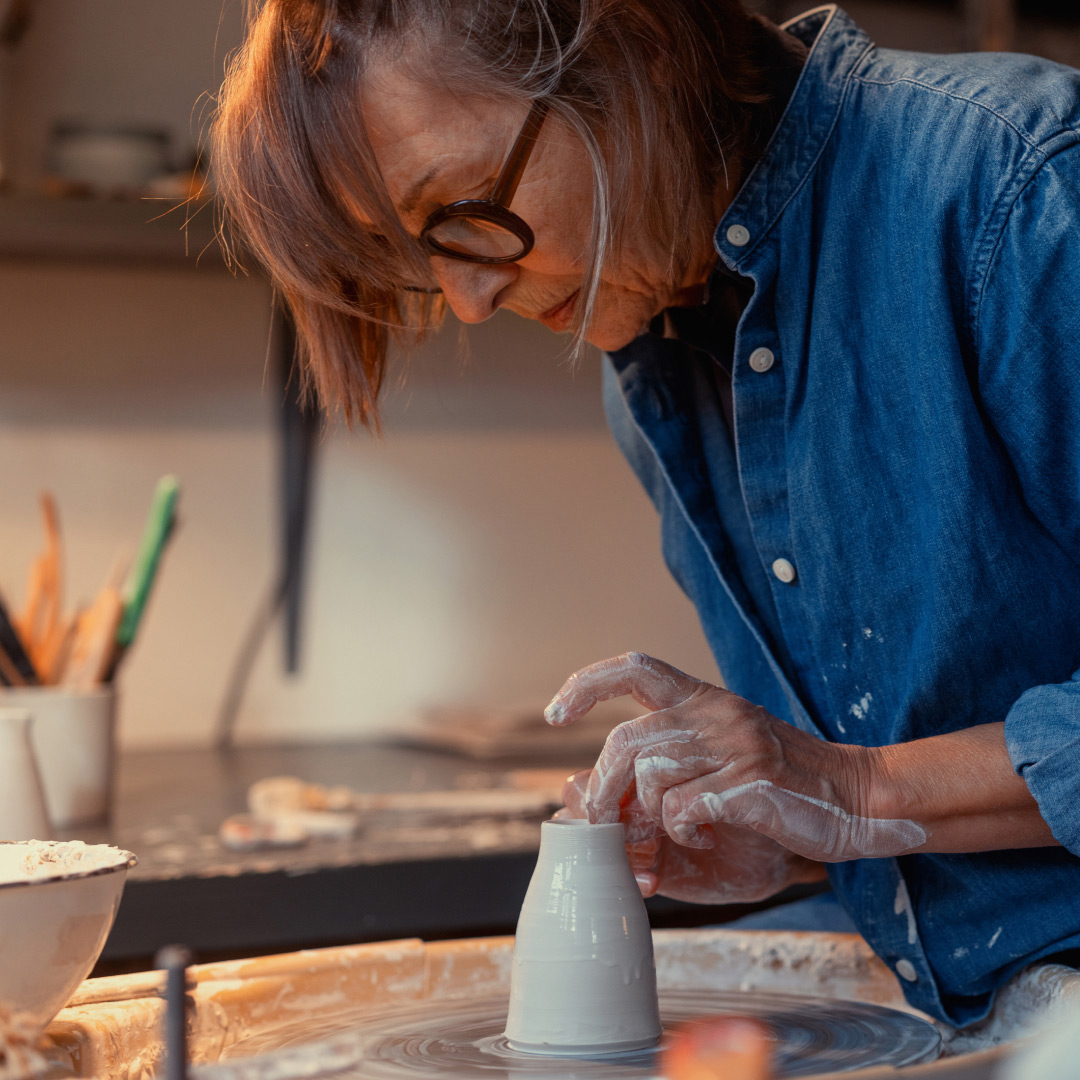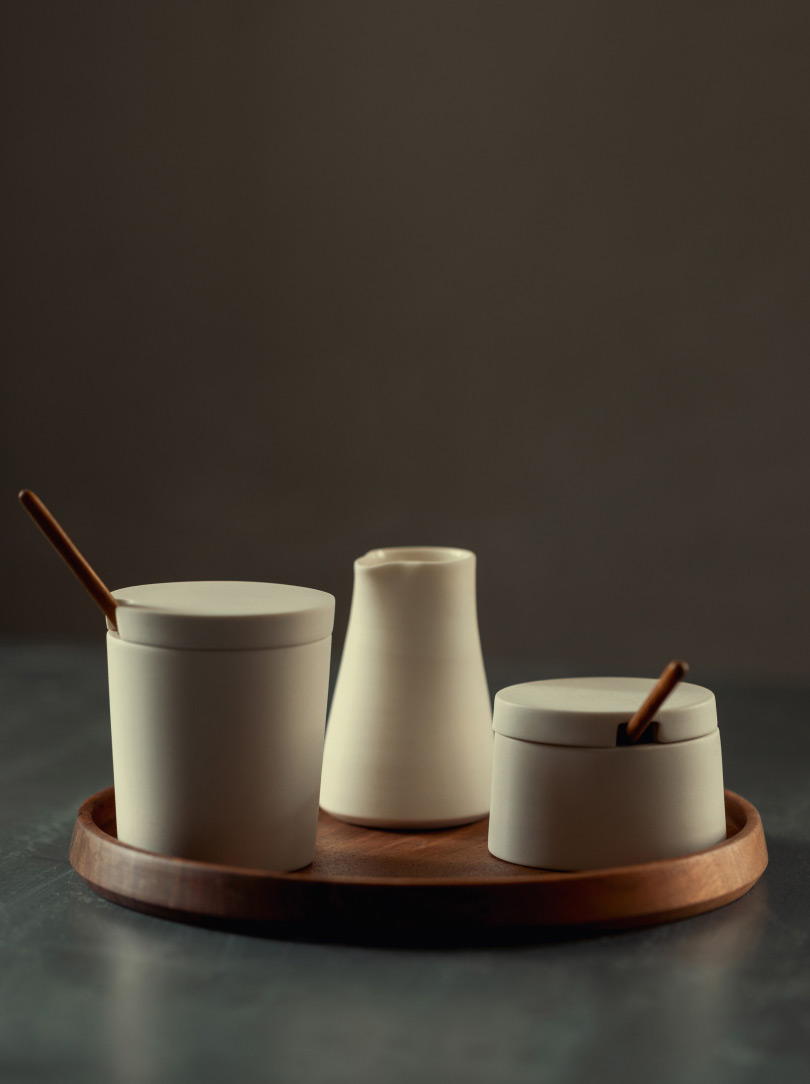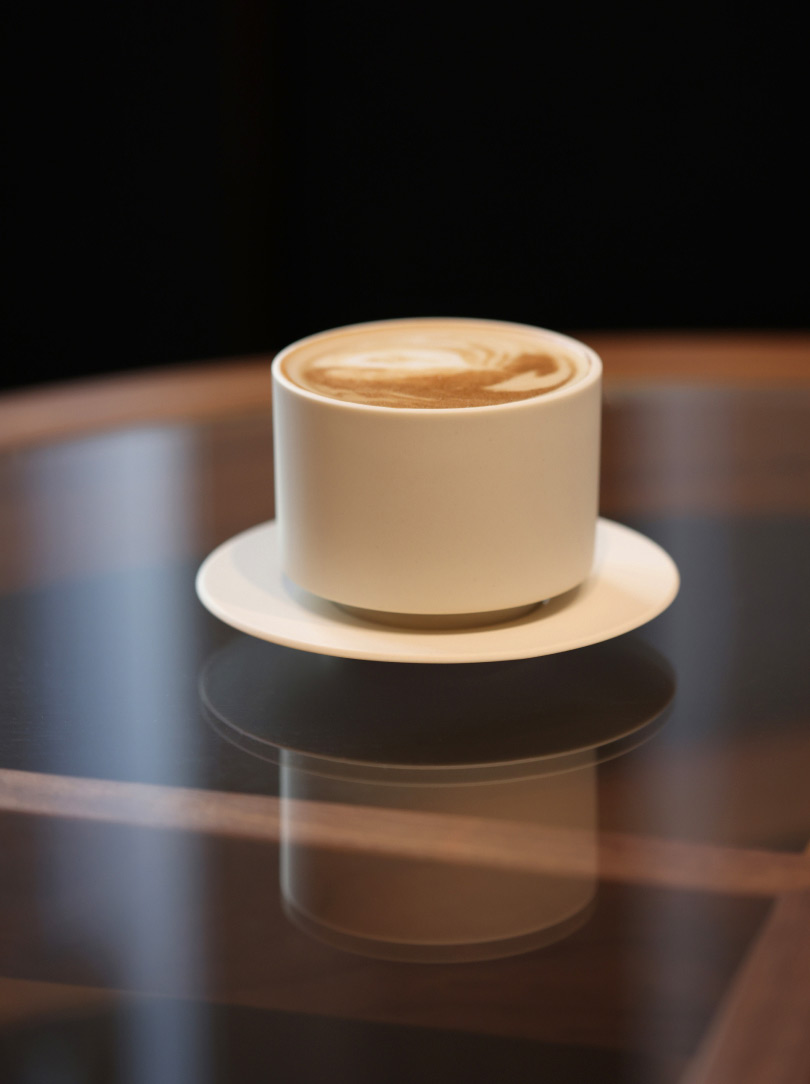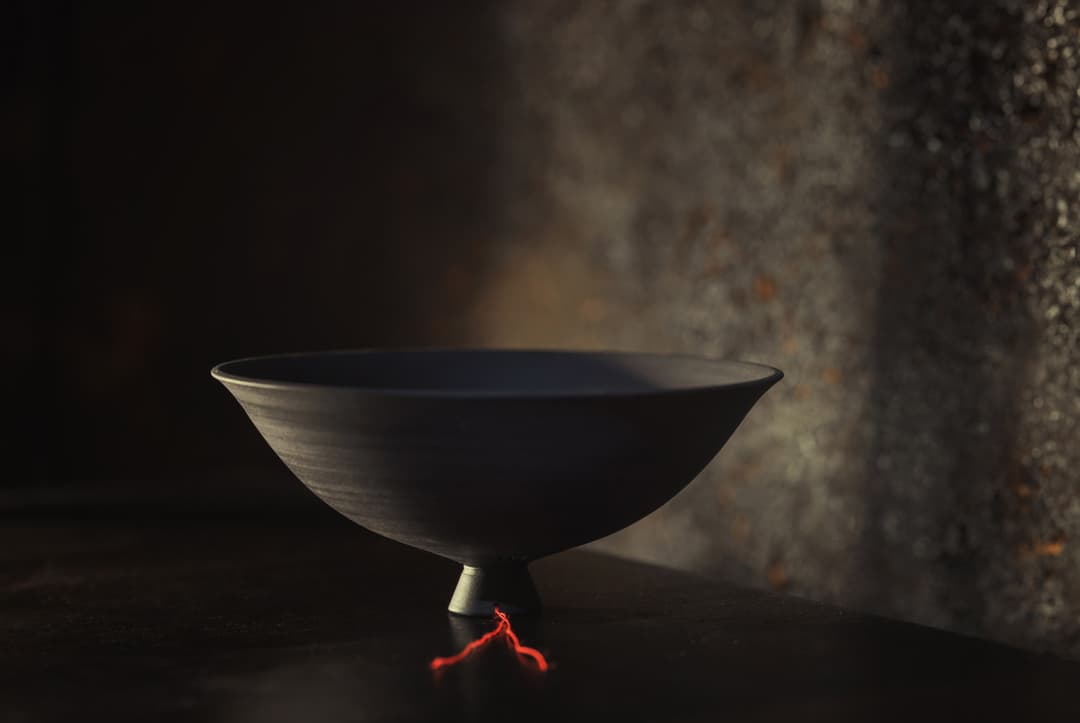
Play Movie

Listen
to Katherine Kennard
reading this story
Japanese-inspired Swiss ceramics
Therese Müller
Therese Müller’s ceramic objects are designed for everyday use, but their beguiling beauty lends them an elevated presence – as sophisticated as it is subtle. Minimalist in appearance, and rigorously precise, they somehow manage to own the space around them. Something about the innate purity of their lines. Perfectly proportioned, yet never contrived. They are strikingly balanced. Simple. Reduced. Yet with surprising warmth and softness. Just like Therese herself.



Her fine build is accentuated by her oversized denim shirt. There is something delicate about her appearance. So, it is almost startling when she throws clay on to her potter’s wheel with full strength. A loud, muted sound reverberates around the room. It actually should not surprise. The work she chose for herself is physically demanding and, in her seventies, she embraces that physicality every day. Her light blue eyes are hidden behind large brown-framed glasses. They suit her. And distract you. They hide the liveliness, attentiveness and curiosity of her eyes.
The tranquillity of home
Therese’s atelier is on the ground floor of her house on ‘Zürichberg’, a hill and residential district overlooking the city of Zurich. A traditional house furnished with minimalistic, modern pieces. A quiet neighbourhood of villas reminiscent of once-upon-a-time influential families. Quite the contrast to where she grew up. Her kitchen is filled with ceramic pieces. Few family portraits. Few memories of distant places. There is a pleasant and unusual easiness in how everything is simply there. As if it were the kitchen of a young couple in their prime. A closer look discovers older ceramics from earlier times, when she was experimenting and searching for her style. Perhaps a reminder of what she no longer is or wants.
“To find your ceramic ‘language’ is difficult,” she says. “There are so many different techniques and types of glazes.” The bright sunlight shines through the tall window front. Not only upstairs but also in her atelier. Sitting at the wheel she looks directly at her garden. A place she loves to be. Where she often starts her working day. Sipping a coffee, looking at her plants, and gently ripping off any dried leaves. A gesture that comes naturally. And renders her garden a little tidier every time.


The restlessness of a creative purpose
When you meet Therese at her atelier, a sense of peacefulness and serenity pervades. She is pleasantly surprised when we remark on this, even a little amused. Because that is not how she feels inside. She feels an unrest. Everything is in turmoil. Her urge to create has not been stilled throughout the years. On the contrary. And yet, when asked what makes her happy, her answer is simple and clear: her work. Because when she works, she can just be. She almost rushes to say that that does not diminish from her sense of family bliss. She has the life experience to know her luck: a family and a partner at her side who love her for her. Her partner takes beautiful pictures of her, which he shows proudly. As a documentarian, his eye is trained to frame beauty just in the right light. She tells it a little differently, with a hint of shyness. She does not enjoy the spotlight as much.
She feels similarly about her ceramic creations. To her, before anything else, they are functional pieces. They are born from her fascination for objects that can contain things, whether liquid or solid. She does not see her objects as art. Nor does she aspire to create art. She is a craftswoman, not an artist. She creates proud, everyday objects. A passion, a purpose even, that she discovered one day, almost by chance.




“Happiness to me is to be able to create. I wish for life to continue like this for as long as possible.”
Therese Müller
Growing up in a working-class family, her father wanted her to work in an office and avoid manual labour. Despite being drawn to craftsmanship, she started to work behind a desk. It was during times of economic growth, when finding a job was easy, so she would work for a few months, travel while her savings lasted, then return to Switzerland to do it all over again. But at a different office, and with different travel plans to dream about.
During her travels, with her then partner, she decided to settle down in São Paulo, Brazil. It was the mid-seventies. Far from her family’s influence, it was time for her new start. She found herself in a marketplace. A Japanese ceramist, Sato Masayuki, was selling his ceramic objects. Then and there, her fascination began. She went to Masayuki-san’s atelier to participate in a workshop. “Women could do that then, but would not be considered for a job,” she says. That did not stop her. Therese showed up every day and finally won a position as assistant to the ceramist. It was a hard beginning. For some time, at the end of each day, her ceramic master would destroy all of her work. All of it. It just wasn’t good enough. Ceramics is an unforgiving discipline.


To this day, with close to fifty years of experience, mistakes still happen. And you cannot fix them. It is only with the very last firing that flaws in the work are revealed. So, at the end of the process you cannot correct them anymore, you just have to start again. Because of that, Therese says that ceramics has been a lifelong teacher in humility. Sometimes she puts aside some of the imperfect pieces. After a few weeks she can look at them again and perhaps discover that they have their own charm. Often her partner sees it right away. But she cannot. She expects them to be a certain way and if they are not, they are not. There is nothing in between. And nothing about it bothers her in the least. She does not mind the hours of work that were ‘lost’. Because they are part of the process.
The value of time
Talking to Therese, you realize that time means something different to her. Not only because her spirit remains young – just as her looks, for that matter. But rather because time is essential to her work and she experiences different aspects of it at once. Some steps are timed exactly. When she works on serial objects, she pours liquid clay into her custom-made containers and leaves it to rest for twenty-seven minutes. No more, no less.



She sets a timer. But she does not really need it. Over the years she has developed an internal clock of sorts. Every time, unfailingly, she returns to the moulds a few instants before the timer goes off. That precision is in absolute contrast with the way the overall process is timed – from beginning to end. “Ceramics requires time,” she says. And she does not like to be rushed. That is why producing on a larger scale is not for her: she would not want rigid schedules to dictate her life. She does not want to waste time either, which might explain why her ceramic objects, though so delicate, are dishwasher safe. Time matters. And perhaps the time her objects take to be made is the reason why she feels she never has enough of it. With age, she has gained more composure, of course. But that restlessness, that sense of time – both at her disposal and running against her – lives deep within.
The simplicity of things
Therese’s ceramic objects are as simple as they are fascinating. There is nothing ‘extra’ about them. They serve a simple purpose. A water jug, a tiny milk pitcher, a saucer, an espresso cup, a jar with its perfectly fitting lid – “because if it does not fit right, then you won’t use it,” she says. This is where her time goes. Not in adorning her objects, but in ensuring they can be used in everyday life. And ensuring that they are a pleasant sensorial experience – for our eyes and hands. This is why sanding is one step that is repeated at different stages. Therese levigates every single object – grinding and polishing, layer after layer, for the end result must be a hard object of unexpected softness. Though repetitive, it is a sequence of movements that has meditative characteristics for Therese. It is not her preferred step in the process, but it is one where her mind can rest or wander. Depending on the day.
Therese is used to working with the main elements – earth, water, air and fire. Her favourite ones are earth and fire. She does not explain her love of fire, and we don’t ask – it is, after all, a fascination that resonates with many. But why earth? Her eyes light up when she speaks about it. Ceramics starts with stones. Hard mountain stone that was reduced to powder through weather conditions and continuous water erosion. From something solid and strong it turns into small particles that, when mixed with water, become soft and malleable. They then become solid again after undergoing two firings. She likes that new-found solidity. She makes objects for a lifetime. If they don’t fall and smash, they will last forever. And “if they fall, they make space for the new”. She says her partner is mortified when one of her objects falls and breaks – every time. She is not. Despite the time that goes into creating it, she does not mind. It has served its purpose for as long as possible.
Therese is an inspiring combination of rigor and ease, of drive and light-heartedness. She appreciates the past but lives in the present. Except for one thing. She misses the youth-like enthusiasm she used to have for all the things she would discover. She used to like and collect so many different objects. But today it happens less. Perhaps it is life experience that helps differentiate what we like and what we love. She thinks about it – without agreeing or disagreeing. Whatever the reason, she misses that feeling. She remembers a stroll in a marketplace in Paris where she discovered some objects of desire. A few porcelain figurines. Delicate and simple. Many visitors might have walked right past them as they are missing some of their limbs. And yet, to Therese, they were and are a cherished treasure. Because she could afford them when money was tight. And because they are delicate, beautiful and perfect to her.

“My ceramic objects are functional. They are made for the everyday – and can last a lifetime.”
The idea of perfection is something that has accompanied her throughout her journey. In a sort of understated way: something to do with her Swiss heritage and Japanese influences. Therese has been living back in Switzerland for over three decades now. It is where she feels at home. But it is not the only place: when she went to Japan for the first time, only a few years ago, she experienced a sense of familiarity. The same feeling she experienced many years ago when she worked at the Atelier Sato Masayuki in Brazil.
To her, many similarities connect the Swiss and the Japanese. Perhaps something that eased her way into the Japanese tradition of ceramics: one that is immense and which influenced her deeply. Her objects fall under the category of soft porcelain, also called bone china – durable and lightweight, it has the greatest resilience of all ceramics. The surface is white, if the clay is not combined with any colours, and often known for its translucence – though Therese chooses to leave many of her objects mat. She often adds a glaze in the inside: even though her objects are waterproof, many think that a mat surface would be porous.


Therese likes soft porcelain because of its strength. It reflects the same sturdiness of the original material it originated from. In fact, clay results from the decomposition of granite and igneous rocks: once the alkalis leach out, quartz, mica and clay remain. The clay used for bone china has a high proportion of kaolinite, a key clay mineral: this whitish, soft and powdery material has an earthy feel to it. Once the clay is dry and has undergone its second firing, Therese levigates it until it feels soft – just as weathering and water levigates granite over centuries. Sometimes she wonders how future citizens will react if her objects are found centuries from now. Will they still be intact? Will they be seen as perfect, even if small pieces might have chipped off? Will they be shown in a museum under glass, like the Roman and Greek objects we look at nowadays? A celebrated craftswoman that has exhibited in museums, galleries and at fairs, she enjoys interacting with the public. And the idea that her pieces land in different places, even in the present, makes her wonder. She wonders how they look in aesthetic worlds different to the ones in which she created them. Only for an instant. Then her mind focuses back on her urge to create. Because that is her purpose. Because that is her joy.






